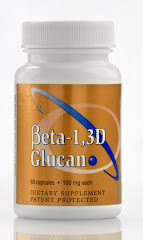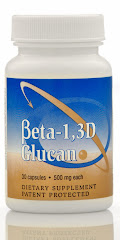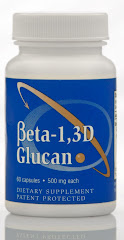The Immune Response Enhanced by Beta-1,3D Glucan by A.J.Lanigan - pg.1
The immune response begins when invaders like viruses enter the body. White blood cells, called macrophages, encounter the invader and consume it. The macrophage does not care what the invader might be. It only knows self or non-self. Meanwhile, other viruses look for nearby cells to infect. Beta-1,3D Glucan, an extract from the cell wall of a baker's yeast, turns the "Woody Allen cells" into "Schwartzenagger cells." This allows your immune system to be "all that it can be". Beta-1,3D Glucan modulates and potentiates the macrophage and keeps it in a more prepared state. With this balancing effect, all subsequent immune response improves. The beta glucan and the macrophages are oblivious to the type of invader or the health of the host. Again, the macrophage only knows self vs. non-self. The glucan treated host will enjoy an increase in its arsenal against unwanted offenders.
Next, the macrophage digests the virus and displays pieces of the virus (antigens) on its surface. Antigens may be any substance introduced into the body that the immune system recognizes as non-self. Nearby cells may become infected by the attacking viruses. In a healthy immune system, these infected cells will come under attack, be destroyed, and be removed before they can be used to spread the illness.
Unique among the different helper T cells (another class of white blood cells) in the body, one particular helper T cell now recognizes the antigen displayed and binds to the macrophage. There are at least two subsets of the helper T cells, the Th1 and the Th2. They make the decisions as to what type response will be ordered. Up and down regulatory factors transmitted by this pair of cells (macrophage + T helper) provide many variations for dealing with the invaders.
This union stimulates the production of chemical substances - such as interleukin-1 (IL-1) and tumor necrosis factor (TNF) by the macrophage, and interleukin-2 (IL-2) and gamma interferon (IFN-y) by the T cell - that allow intercellulor communication. Theses cytokines/lymphokins (fax messages) are required for T cell activation and response. Mere activation is not enough. The Antigen Presenting Cell (APC), depending on the type (MHC I or II) of presentation gives co-stimulation (a second go-ahead signal). CD28 (blood test) reflects this co-stimulation and activation process. - source
Transfer Point Beta Glucan # 300, Scientifically Proven to be The Ultimate in Beta Glucans
Contact:
Healthful Links
Labels
- 3-D Glucan (1)
- 3D Glucan (1)
- A.J. Lanigan (3)
- aging (1)
- allergies (3)
- Alveolar cells (1)
- Analysis (1)
- Animals (2)
- anthrax research (1)
- anthrax spores (1)
- antibody formation (1)
- antigens (3)
- APC (1)
- ash levels (1)
- athletes (1)
- Auburn University (1)
- Authorized Distributor of Transfer Point Beta Glucan (1)
- autoimmune (1)
- Autoimmune Disease (2)
- B cells (2)
- bakers yeast (8)
- BakersYeastBetaGlucan (5)
- barley (1)
- basophils (1)
- Best Beta Glucan (1)
- Beta Bitts (2)
- Beta Glucan (15)
- Beta Glucan Anti Stress Report (1)
- Beta Glucan Research (1)
- Beta Glucan sources (1)
- beta glucan technology (1)
- Beta Glucan: Nature's Secret (1)
- Biological response modifiers (1)
- bone marrow (2)
- Brain cells and tissue (1)
- brain imaging (1)
- breast cancer (1)
- C3 protein (1)
- cancer (4)
- cancer research (1)
- cardiovascular disease (1)
- cell wall of bakers yeast (1)
- Certificate of Analysis (2)
- chemotaxis (1)
- chemotherapy (2)
- chemotherapy recovery (1)
- Chi Machine (1)
- Cholesterol (1)
- cholesterol research (1)
- Chronic Stress (1)
- Class II MHC molecule (1)
- clinical trials (1)
- Common Cold (1)
- CoQ10 (1)
- corticosterone (1)
- CTLs (1)
- cytokine (5)
- cytotoxic T lymphocytes (1)
- Dosage (2)
- Dr. Jana Vetvickova (1)
- Dr. Vaclav Vetvicka (5)
- Endocytosis (1)
- Enterocytes (1)
- Enterones (1)
- eosenophils (1)
- FIR Dome (1)
- Flu (1)
- Gamma-Interferon (1)
- genetically engineered foods (1)
- Glucan (2)
- Glucan #300 (5)
- Glucan 300 (2)
- Glucan Research (1)
- Glucose molecules (1)
- grains (1)
- HealthIsInReach (1)
- hematopoiesis (1)
- hemotopoeisis (1)
- Homologous polysaccahides (1)
- hospital acquired infections (1)
- Human parainfluenza viruses (1)
- IL-1 (2)
- IL-2 (4)
- illness (1)
- immune cells (1)
- immune modulator (3)
- immune protection (1)
- immune response (5)
- immune stimulating component (1)
- immune supplement (1)
- Immune support (1)
- immune system (11)
- Immune System support (1)
- immuno-modulating properties (1)
- Immunologists (1)
- immunomodulator (1)
- infectious disease (1)
- infectious disease research (1)
- interleukin-1 (1)
- interleukin-2 (1)
- Journal of Medicinal Foods (1)
- Journal of the American Nutraceutical Association (1)
- LDL cholesterol (1)
- Long Chain Polysaccharide (2)
- Lymph nodes (1)
- Lymphatic System (1)
- Lymphoma (1)
- Macromolecules (1)
- macrophages (6)
- Major Histocompatibility Complex (2)
- mediated immune response (1)
- MHC (2)
- MHC I complex (1)
- Microglial cells (1)
- monoclonal antibody (1)
- mushrooms (1)
- myelosupression (1)
- natural alternatives (1)
- Natural Immunomodulators (1)
- natural killer cells (1)
- Neutrophil cells (1)
- neutrophils (2)
- New Book Release (1)
- NK cells (2)
- NPcaps (1)
- NPcaps capsules (1)
- Number one Beta Glucan (1)
- oat (1)
- Open Glycoscience (1)
- oral Beta glucan (1)
- Original Sun Ancon Chi Machine (1)
- patents (3)
- Pet (1)
- PET Scans (1)
- phagocytes (2)
- phagocytosis (4)
- Polysaccharides (1)
- Potency (1)
- Product line (1)
- Professor of Pathology (1)
- protein levels (1)
- Pullulan (1)
- radiation (1)
- radiation protective effect (1)
- radiation recovery (1)
- radiation research (1)
- Resveratrol (1)
- Retroperitoneal Lymph nodes (1)
- Saccharomyces cerevisiae (2)
- seaweed (1)
- Selenium (1)
- stem cells (1)
- stress (2)
- T cells (4)
- Th1 (1)
- Th2 (1)
- TNF (1)
- toxins (1)
- Transfer Point (11)
- Transfer Point Beta Bitts (1)
- Transfer Point Beta Glucan (14)
- Transfer Point Beta Glucan out performs the rest (1)
- Transfer Point Beta Glucan outperforms all other immune supplements tested (1)
- Transfer Point Beta Glucan Purity (2)
- Transfer Point Beta Glucan supplier (1)
- Transfer Point Beta-1 (1)
- tumor (1)
- universities (1)
- University of Louisville (2)
- viruses (1)
- What is Beta 1 (1)
- What is Beta Glucan? (1)
- white blood cells (1)
- Yeast beta glucan (2)
- Yeast cell walls (1)
These statements have not been evaluated by the Food and Drug Administration.
The information provided is not intended to diagnose, treat, cure or prevent any disease.
The information provided is not intended to diagnose, treat, cure or prevent any disease.



